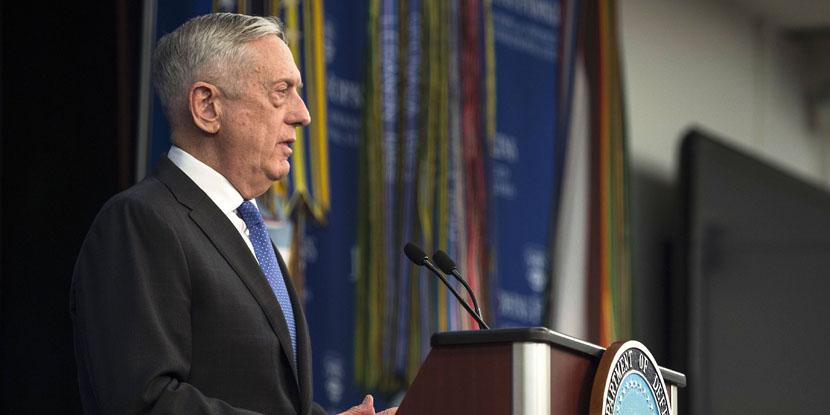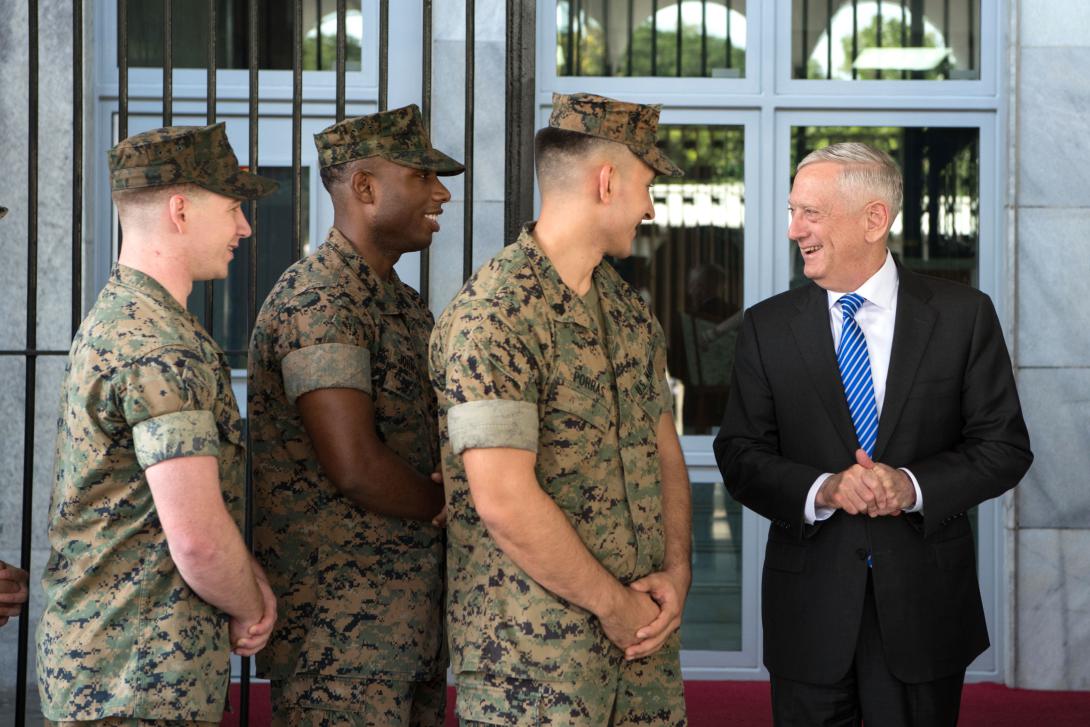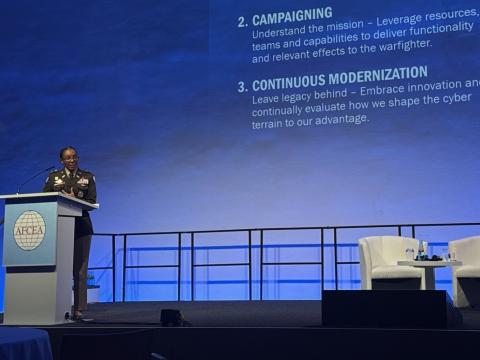Mattis Outlines National Defense Strategy
No longer can the U.S. military bank on ensured victories. The battlefield is more lethal and disruptive, is conducted at breakneck speeds and reaches further around the globe. And although fighting terrorism has gripped the military’s focus for the last 16 years, it is the rise of so-called inter-state strategic competition against nations such as China and Russia that will now be the primary concern for U.S. national security.
“We are facing increased global disorder, characterized by decline in the long-standing rules-based international order—creating a security environment more complex and volatile than any we have experienced in recent memory,” according to U.S. Defense Secretary Jim Mattis. “China and Russia are now undermining the international order from within the system by exploiting its benefits while simultaneously undercutting its principles and ‘rules of the road.’ Moreover, an increasingly complex security environment is defined by rapid technological change and challenges from adversaries in every operating domain. Every domain is now contested—air, land, sea, space and cyberspace.”
Secretary Mattis outlined the threats to U.S. national security as part of the release of the unclassified version of his 2018 National Defense Strategy. He called for a “more lethal, resilient and rapidly innovating joint force, combined with a robust constellation of allies and partners,” in order to “sustain American influence and ensure favorable balances of power that safeguard the free and open international order.”
The problem is that the longest continuous stretch of armed conflict in American history has had an impact on the U.S. military’s current readiness. Moreover, the increasing digital connectivity of the Internet of Things across all aspects of life is creating “significant vulnerabilities” for businesses, the government and the military. During conflict, attacks will come against the country's critical defense, government and economic infrastructure, Mattis predicted. That, combined with such rapid technological advancements, calls for a shift in the U.S. military’s operational paradigm. “The reemergence of long-term strategic competition, rapid dispersion of technologies and new concepts of warfare and competition that span the entire spectrum of conflict require a joint force structured to match this reality,” the Secretary said.
In the secretary’s view, the American military’s foundational capabilities will include: nuclear; cyber; space; command, control, communications, computers and intelligence, surveillance, and reconnaissance (C4ISR); strategic mobility; and counter-weapons of mass destruction proliferation.
In particular, the nation’s—and the world’s—cybersecurity will continue to be at great risk. “Terrorists, transnational criminal organizations, cyber hackers and other malicious non-state actors have transformed global affairs with increased capabilities of mass disruption. Here, Mattis does see a growing defense, given “our partners in sustaining security are also more than just nation-states—multilateral organizations, nongovernmental organizations, corporations and strategic influencers provide opportunities for collaboration and partnership.”
The secretary outlined five main adversaries: China, Russia, North Korea, Iran, and terrorists. China is leveraging military modernization, influence operations using and predatory economics. The strategic competitor to the United States is using its might to intimidate its neighbors while militarizing features in the South China Sea, reordering the Indo-Pacific region to its advantage.
“As China continues its economic and military ascendance, asserting power through an all-of-nation long-term strategy, it will continue to pursue a military modernization program that seeks Indo-Pacific regional hegemony in the near-term and displacement of the United States to achieve global preeminence in the future,” Mattis stated. “The most far-reaching objective of this defense strategy is to set the military relationship between our two countries on a path of transparency and nonaggression.”
Russia has violated the borders of nearby nations and pursues veto power over the economic, diplomatic and security decisions of its neighbors. The country is seeking to shatter NATO and change European and Middle East security and economic structures to its favor, according to the secretary. “The use of emerging technologies to discredit and subvert democratic processes in Georgia, Crimea and eastern Ukraine is concern enough, but when coupled with its expanding and modernizing nuclear arsenal, the challenge is clear,” he stated.
Meanwhile, North Korea’s “outlaw actions and reckless rhetoric” continue despite the United Nations' censure and sanctions. “North Korea seeks to guarantee regime survival and increased leverage by seeking a mixture of nuclear, biological, chemical, conventional and unconventional weapons and a growing ballistic missile capability to gain coercive influence over South Korea, Japan and the United States,” Mattis implored.
In the Middle East, Iran continues to sow violence. Mattis attested that the country remains “the most significant challenge” to Middle East stability. “Iran is competing with its neighbors, asserting an arc of influence and instability while vying for regional hegemony, using state-sponsored terrorist activities, a growing network of proxies and its missile program to achieve its objectives,” he said. The rogue regimes of both North Korea and Iran seek to destabilize their regions through pursuit of nuclear weapons or sponsorship of terrorism.
All of these competitors and adversaries are employing tactics that are just short of open warfare, including information warfare, ambiguous or denied proxy operations, and subversion, Mattis said. They are also targeting the U.S. military’s battle networks and operational concepts. “These trends, if unaddressed, will challenge our ability to deter aggression,” he warned.
The secretary predicted that terrorism would remain “a persistent condition,” driven by ideology and unstable political and economic structures. “Despite the defeat of ISIS’ physical caliphate, threats to stability remain as terrorist groups with a long reach continue to murder the innocent and threaten peace more broadly,” Mattis stressed. “It is now undeniable that the homeland is no longer a sanctuary. America is a target, whether from terrorists seeking to attack our citizens; malicious cyber activity against personal, commercial, or government infrastructure; or political and information subversion.”
For C4ISR, the DOD will prioritize the development of “resilient, survivable, federated networks and information ecosystems from the tactical level up to strategic planning.” The military’s investments also will focus on “capabilities to gain and exploit information, deny competitors those same advantages and enable us to provide attribution while defending against and holding accountable state or non-state actors during cyber attacks,” he outlined.
Additionally, the emergence of space and cyberspace as warfighting domains means the DOD must “prioritize investments in resilience, reconstitution and operations to assure our space capabilities,” Mattis stated. “We will also invest in cyber defense, resilience and the continued integration of cyber capabilities into the full spectrum of military operations.”
To meet this changing technological character of war, advanced computing, big data analytics, artificial intelligence, autonomous systems, robotics, directed energy, hypersonic technology and biotechnologies will all play a role. “The drive to develop new technologies is relentless, expanding to more actors with lower barriers of entry, and moving at accelerating speed,” he shared.
The commercial sector, especially, is driving technological advances, which means that nation-states and non-state actors have easy access to them, “a fact that risks eroding the conventional overmatch to which our nation has grown accustomed,” according to Mattis. This “requires changes to industry culture, investment sources and protection” across the entire security innovation base for the DOD to maintain a technological advantage.
"We cannot expect success fighting tomorrow’s conflicts with yesterday’s weapons or equipment,” Mattis emphasized. “To address the scope and pace of our competitors’ and adversaries’ ambitions and capabilities, we must invest in modernization of key capabilities through sustained, predictable budgets. Our backlog of deferred readiness, procurement and modernization requirements has grown in the last decade and a half and can no longer be ignored. We will make targeted, disciplined increases in personnel and platforms to meet key capability and capacity needs.”






Comments